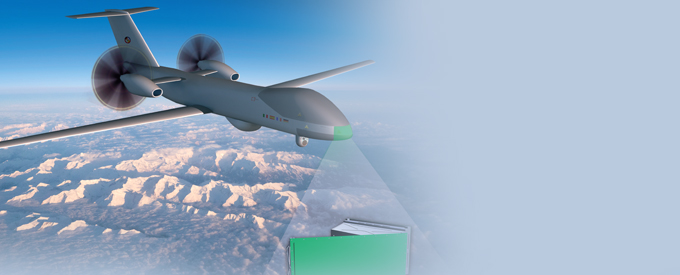2019-11-13
Sensors Replace Pilots
For the first time, the companies Diehl and HENSOLDT tested together with the German Aerospace Center (DLR) a new sensor system to increase safety in air traffic. The main idea behind this new sensor system tested is to prevent collisions between aircrafts. In the future, the tested sensors for detection and avoidance of collisions ("Sense & Avoid") could for the first time permit the approval and operation of unmanned aerial vehicles (drones) in German airspace.
In view of the ever-increasing use of unmanned aerial vehicles (UAVs) for multiple applications, Sense & Avoid systems have assumed increasing relevance in the last decade. To ensure a suitable level of safety for these pilot-less platforms, the vehicle should first be provided with the capability of seeing and being seen. They should then be capable of avoiding loss of separation and collision with respect to surrounding traffic.
Many efforts have been made worldwide to study these new sensors and to develop suitable technological solutions, accounting for several constraints to compliance for sense-and-avoid systems for UAVs. Indeed, in a three-week long flight campaign at the Braunschweig research airport, modern sensors were demonstrated capable of replacing the pilot's eye in flight tests carried out over 30 hours.
For this purpose, the DLR research aircraft Dornier Do 228 was equipped with a "dual-mode sensor suite" manufactured by Diehl and HENSOLDT and consisting of radar and electro-optical sensors, where the optical signals of special cameras were combined with radar signals. In addition to DLR's Do 228, one more test aircraft was used for the tests. This aircraft made extensive manoeuvres from different directions and heights in order to be detected by the sensor system of the Do 228. The flight tests showed that the sensor suites detect the other aircraft at even long distances in a reliable, accurate manner. From here, they track an aircraft precisely, capable of warning their own aircraft of a potential collision course in time.
The electro-optical module of Diehl consists of a series of high-resolution cameras scanning the area in front as well as the side of the aircraft. This system has been proven to replace the pilot's view and significantly increase the accuracy of the overall system because the module is lightweight, compact and can be flexibly modified to meet the requirements of different aircrafts.
HENSOLDT’s "Detect-and-Avoid" radar operates via electronic beam steering technology (Active Electronically Scanned Array, AESA) enabling several detection tasks to be performed simultaneously and objects to be detected extremely quickly. Thanks to radar technology, the flight direction of objects in one's own flight path can be measured precisely in order for sufficient time and warning to be given against potential collisions.
Hence, with its unique detection properties, the multi-functional radar is suitable for military as well as civilian drones, e.g., for cargo delivery, while the sensor also handles all the functions of a weather radar. The combination of these two technologies in a dual-mode sensor system is suitable for unmanned aerial vehicles of different sizes, which also have excellent detection properties.
Full Spectrum of Tasks
The universal DLR research aircraft has been regularly equipped and used as a flying platform for a wide variety of research tasks. Indeed, for research into unmanned aerial systems, it serves as a "National Sense & Avoid Demonstrator".
In using a new type of digital autopilot, the aircraft can be automatically controlled from a ground station. It can also safely simulate an unmanned aerial system since two safety pilots are always onboard the aircraft.
The flight tests were conducted as part of the "Project Sense and Avoid - national" (ProSA-n) project commissioned by the Bundesamt für Ausrüstung, Informationstechnik und Nutzung der Bundeswehr (BAAINBw). The DLR is the aerospace research centre of the Federal Republic of Germany, with extensive research and development work in aviation, space, energy, transport, security and digitisation integrated into national and international collaborative ventures.
In addition to its own research, the DLR acts as a space agency responsible for the planning and implementation of the German space programme commissioned by the federal government. The DLR is also the umbrella organisation for one of the biggest project promoters of Germany.
The BAAINBw was established on 1st October 2012 as part of the realignment of the armed forces. Structurally, the Federal Office and its subordinate departments have 11,000 employees across the country with more than 5,000 people based at the location in Koblenz.
The Federal Office is assisted by a technologically and scientifically broad-based business division boasting six military technology and two military science departments, while the Naval Arsenal in Wilhelmshaven provides the ships and boats of the German Navy as an additional department. In turn, a liaison department in Reston, U.S., represents the military technology and armament interests with regard to the American and Canadian bodies as well as for local industry.
Reference Text/Photo:www.diehl.com,www.dlr.de,www.hensoldt.com


No Comments